The Intel Broadwell Xeon E3 v4 Review: 95W, 65W and 35W with eDRAM
by Ian Cutress on August 26, 2015 9:00 AM ESTSPECviewperf 12 on a GTX 980
From popular demand, we have introduced SPECviewperf 12 into our testing regimen from August 2015. SPEC is the well-known purveyor of industry standard benchmarks, often probing both fundamental architectural behavior of processors and controllers, as well as comparing performance with well understood industry software and automated tools. It is this last point we pick up – SPECviewperf 12 tests the responsiveness of graphics packages in the fields of design, medical, automotive as well as energy. The benchmarks focus purely on responsiveness and the ability to both display and rotate complex models to aid in design or interpretation, using each packages internal graphics schema (at 1080p). We run this set with a discrete graphics card, similar to the workstation environments in which they would be used. As a new benchmark, we are still filling the system with data.

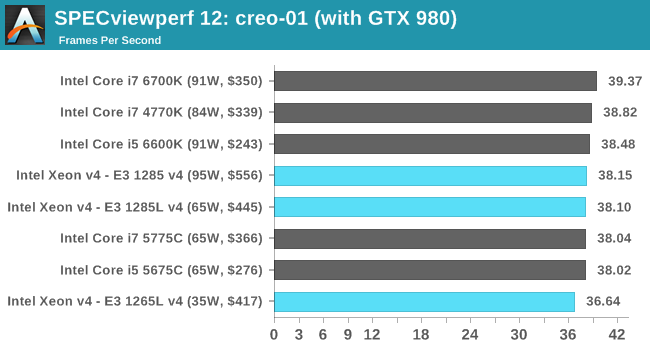
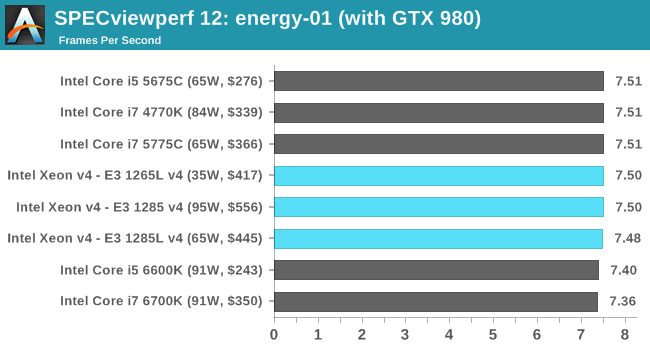
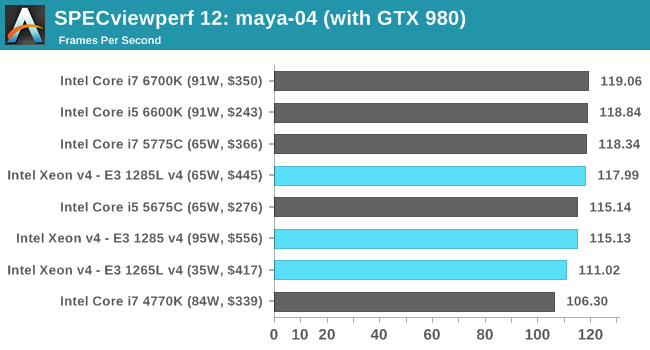
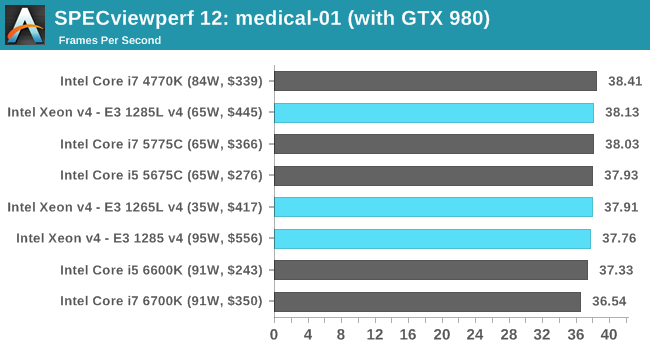
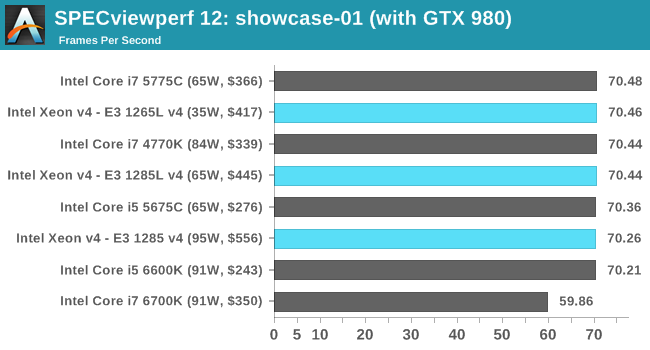
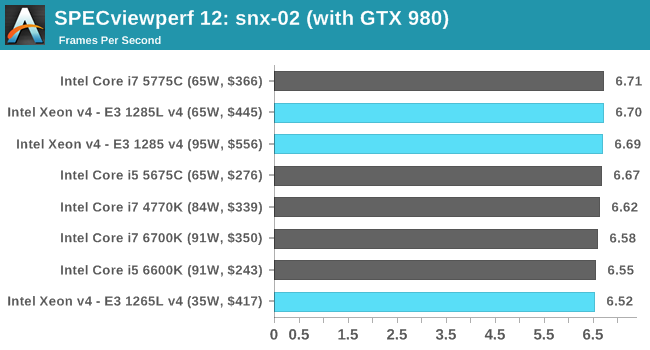
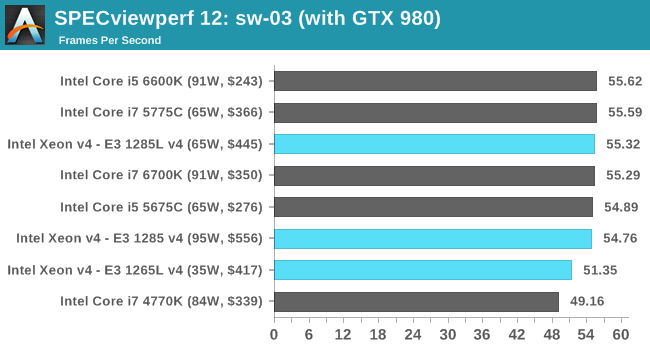
At a certain point it seems that most tests are graphics card bound, however a few show up that having the fastest processor makes a difference. Differences from the Haswell platforms score +5% at best, although a bigger difference can be seen going further back in CPU generations. At this point with a discrete graphics card, SPECviewperf's tests are more akin to our gaming tests when it comes to responsiveness.










72 Comments
View All Comments
piasabird - Wednesday, August 26, 2015 - link
At $446 this isn't exactly an entry level CPU. I wonder where are the desktop CPU's with IRIS graphics like the i5-5575r which is suppose to be priced at $244 and available now but is not for sale anywhere?piasabird - Wednesday, August 26, 2015 - link
I guess Intel makes this processor but would rather have you buy a more expensive one. What is up with this? Same thing goes for i5-5675cdgingeri - Wednesday, August 26, 2015 - link
It's not meant to be a cheap CPU. It's a workstation/server chip. I has some additional data integrity features that the normal desktop CPUs can't use, like ECC memory. The drivers for the GPU are also optimized and tested for workstation level software, which is expensive to do. Sometimes, just frequency isn't enough.Camikazi - Friday, August 28, 2015 - link
I always wonder how people don't see that a server part is going to be more expensive than a desktop part. They always have been and always will be because they are binned higher and have additional features that desktops don't or can't use. Saying that $446 for this CPU is actually rather cheap for an entry level Xeon CPU and is not a bad price.Free008 - Tuesday, September 1, 2015 - link
Thats right it's too expensive. Intel will continue to gouge consumers with lower quality binned parts and disabled server features until Apple starts making decent desktop CPUs and then we can forever leave Intel and Microsoft at our leisure. Thats why none of the mobile Intel CPUs are selling - most the suppliers dont want to go back to the old monopoly days regardless of performance (which isn't incrementally significantly anymore anyway, just power savings). Intel thinks suppliers and consumers will put up with this forever but they are so wrong. It's just a matter of time now.zoxo - Wednesday, August 26, 2015 - link
It is rather disappointing that it seems that energy efficiency has regressed since the awesome 4790K. I was hoping that switching to 14nm would allow intel to do what the 88W 4790K could do in the 65W power envelope, but neither broadwell or skylake seems to be able to deliver that promise.mmrezaie - Wednesday, August 26, 2015 - link
I am also wondering why even though the performance is not changing that much but why power usage is not getting that much better!milkod2001 - Wednesday, August 26, 2015 - link
While CPU performance of the chip is only a little bit better, its GPU part is much bigger and performs much better, hence power consumption is the same as older chips. It's actually an achievement.For regular desktop CPUs i'd prefer Intel to give us native mainstream 6 core with no GPU at all.
But that would not played nicely with premium E series CPU. Money, money, money. Give me more :)
zoxo - Wednesday, August 26, 2015 - link
If you consider pure CPU loads, broadwell/skylake doesn't seem to show much power advantage over devil's canyon when you are getting to the 4GHz range. Skylake seems to be more overclock friendly, but it does consume a lot of power doing it.azazel1024 - Friday, August 28, 2015 - link
I was thinking the same thing based on Anandtech's original tests, but if you look at their notes under the delta power consumption and looking at a few other review sites, it looks a lot like motherboard manufacturers are all over the board with voltage/frequency curves for Skylake (and I assume here with Broadwell too) and it is biting them in the butt on power consumption. You've got a difference of easily 35% in power consumption from one board to the next using the same chip.Using the better numbers I have seen in some tests, Skylake, specifically the 6700k is actually significantly better than any other generation in performance per watt. Looking at the higher numbers in a few reviews, it is much worse than Broadwell and Haswell and only fractionally better than Ivy Bridge. I suspect that Skylake and probably Broadwell, that Intel's 14nm process has poor voltage/frequency scaling. Also that most motherboard manufactures are choosing poor voltage curves for the chip in an attempt to be extremely conservative.
A knock on effect here is, it is likely to be impacting actual performance too. If the 6700k has a TDP of 94w and the Dp is 110w...I'd half imagine that there is some throttling going on there with some loads.